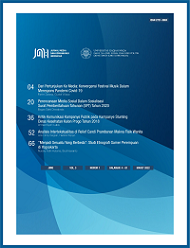Comparative Study of Local Government Website Quality as Implementation Of E-Government Public Relations in Public Information Disclosure
Wahyu Eka Putri(1*), Ascharisa Mettasatya Afrilia(2)
(1) Program Studi Ilmu Komunikasi, Fakultas Ilmu Sosial dan Ilmu Politik, Universitas Tidar
(2) Program Studi Ilmu Komunikasi, Fakultas Ilmu Sosial dan Ilmu Politik, Universitas Tidar
(*) Corresponding Author
Abstract
Law Number 14 of 2008 concerning Public Information Disclosure (UU KIP) has brought logical consequences for all local governments in creating an information climate that is transparent, accurate and easily accessible to the public via the website. Therefore, efforts are needed to improve the quality of websites both in quantity and quality at the local government level. This study aims to determine the quality of the websites of the City Government of Magelang and the Government of Magelang Regency. The research method used is a qualitative method with a comparative approach with a unit of analysis in the form of a number of elements contained in the principle of dialogical communication. The results of the study show that referring to the five elements of dialogic communication, it is known that the Magelang City Government website and the Magelang Regency Government website have fulfilled a number of elements such as information updates, photo availability, and complaint facilities. However, there are still elements that have not been maximized, namely features that are two-way communications.
Keywords
Full Text:
Studi Komparasi - Putri_AfriliaReferences
Afrilia, A. M., Rhizky, D. P., Putri, W. E., & Ratnasari, E. (2023). The digital competence of government public relations officer in Magelang City. PRofesi Humas, 7(2), 215–233. https://doi.org/10.24198/prh.v7i2.43146
Agyemang, F.G., Boateng, H., & Dzandu, M.D. (2015), Dialogic communication on universities in Ghana libraries’ websites. The Electronic Library, 33(4), 684–697. https://doi.org/10.1108/EL-02-2014-0041
Alexander, D. M. (2016). What digital skills are required by future public relations practitioners and can the academy deliver them? PRism, 13(1), 1–13.
Aprilia, W., & Suryadi. (2014). Efektivitas website sebagai media e-government dalam meningkatkan pelayanan elektronik pemerintah daerah (Studi pada website Pemerintah Daerah Kabupaten Jombang). Universitas Brawijaya
Azhari, S. 2017. Evaluasi RP online badan publik di Indonesia dalam upaya transparansi dan akuntabilitas informasi kepada publik. [Thesis]. Universitas Brawijaya
Fandi, A. (2019). Evaluasi website Pemerintah Kabupaten Sleman. Universitas Gadjah Mada.
Gant, J., & Turner-Lee, N. (2011, Maret 4). Government transparency: Six strategies for more open and participatory government. Knight Foundation. https://knightfoundation.org/reports/government-transparency-six-strategies-more-open-a/
Guillory, J., & Sundar, S.S. (2008). Can interactivity in corporate websites influence public perceptions of organizations? Conference paper International Communication Association.
Holzschlag, M. E. (2001). Freedom in structure. Web Techniques, 6(7), 26-30.
Huri, D. (2014). Penguasaan kosakata kedwibahasaan antara bahasa Sunda dan bahasa Indonesia pada anak-anak (Sebuah analisis deskriptif-komparatif). JUDIKA (JURNAL PENDIDIKAN UNSIKA), 2(1). https://doi.org/10.35706/judika.v2i1.122
Kelleher, T. (2007). Public relations online lasting concept for changing media. Sage Publications
Kriyantono, R. (2017). Teori-teori public relations perspektif barat & lokal: Aplikasi penelitian dan praktik. Kencana
Kriyantono, R. (2019). Public relations activities of state universities based on excellence theory. Avant Garde, 7(2), 154–170. DOI:10.36080/ag.v7i2.901
Kriyantono, R. (2021). Best practice humas (public relations) bisnis dan pemerintah. Prenada Media.
Maulana, A. (2017, Mei 19). Ini yang harus diperhatikan praktisi humas di era keterbukaan informasi publik. Layanan Informasi Publik Universitas Padjadjaran. https://www.unpad.ac.id/2017/05/ini-yang-harus-diperhatikan-praktisi-humas-di-era-keterbukaan-informasi-publik/
Nirmalasari, A. (2020). Crisis management in public relations: Meta-synthesis analysis of online activism. Jurnal Penelitian Komunikasi Dan Opini Publik, 24(2). https://doi.org/10.33299/jpkop.24.2.2446
Noor, M. U. (2019). Inisiasi masyarakat informasi di Indonesia melalui implementasi keterbukaan informasi publik: Satu dekade Undang-Undang Keterbukaan Informasi Publik. Khizanah al-Hikmah Jurnal Ilmu Perpustakaan Informasi dan Kearsipan, 7(1). https://doi.org/10.24252/kah.v7i1a2
Permatasari, A.N., Soelistiyowati, E., Suastami, I.G.A.P.P., Johan, R.A. (2021). Digital public relations: Trend and required skills. Jurnal ASPIKOM, 6(2). http://dx.doi.org/10.24329/aspikom.v6i2.836
Ratnasari, E., Rahmat, A., & Prastowo, F. A. A. (2018). Peran humas perguruan tinggi negeri badan hukum dalam implementasi kebijakan keterbukaan informasi. PRofesi Humas, 3(1), 21–38. https://doi.org/10.24198/prh.v3i1.14034
Sugiyono. (2020). Metode penelitian kombinasi (Mixed methods). ALFABETA.
Wahanu., & Prasetyo. (2013). Vox Pers Vox Partai. [Online] tersedia di https://jdih.bappenas.go.id/artikel/countviewer/Aspek_Hukum_logo_pemerintah1.pdf
Article Metrics
Refbacks
- There are currently no refbacks.
Copyright (c) 2023 Jurnal Media dan Komunikasi Indonesia

This work is licensed under a Creative Commons Attribution-ShareAlike 4.0 International License.
| Jurnal Media dan Komunikasi Indonesia (Online ISSN 2721-396X) is published by the Department of Communication Science (DIKOM), Faculty of Social Science and Political Science (FISIPOL), Gadjah Mada University |













